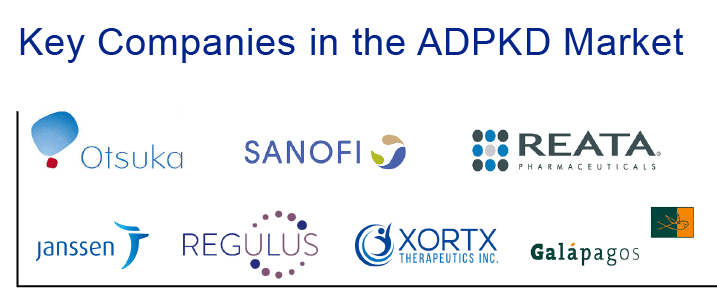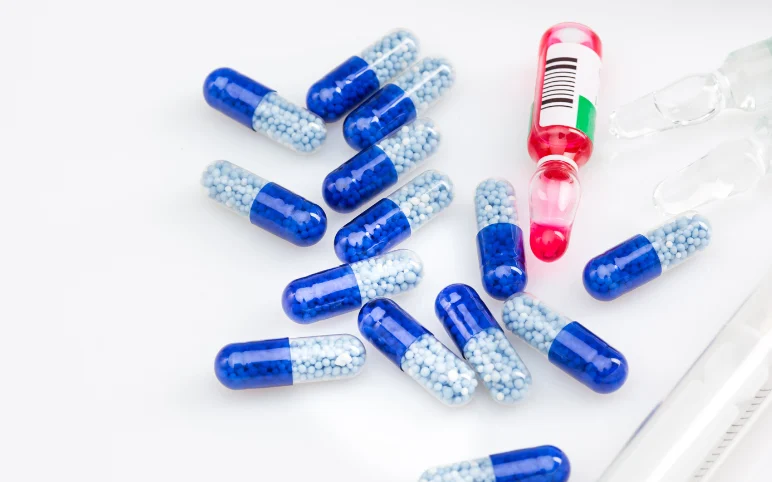Advancing Therapeutic Outlook for Autosomal Dominant Polycystic Kidney Disease (ADPKD) Treatment
Jul 29, 2022
Key Highlights
- The US approval of Jynarque added the much-needed push to the ADPKD treatment market.
- In the coming years, Bardoxolone methyl is expected to be an effective therapy for ADPKD treatment.
- The current ADPKD treatment only aims to delay the disease progression rather than completely cure the disease, which leads to an unmet need for ADPKD management.
Autosomal dominant polycystic kidney disease (ADPKD) is the most frequent type of PKD. ADPKD affects approximately 1 in every 400 to 1,000 individuals and is the most common kidney disease passes down via families. According to NAMCS (National Ambulatory Medical Care Survey), which was conducted by the Centers for Disease Control and Prevention (CDC) and the National Center for Health Statistics (NCHS) in the US, the diagnosed prevalence rate for ADPKD was observed to be 4.3 per 10,000.
Moreover, as per our analysis, the total diagnosed prevalent cases of ADPKD were around 367K in the 7MM in 2021. These cases are further anticipated to rise by 2032. Furthermore, it was observed that in the US in 2021, ADPKD was most prevalent in the 44-64 years age group.
Downloads
Click Here To Get the Article in PDF
However, epidemiology data for ADPKD is limited, and most studies consider the prevalence rate available in the previously published research studies. There is a dire need for a dataset/epidemiological study that includes a large cohort of ADPKD diagnosed pools.
Currently, there is no effective curative treatment for ADPKD, and most efforts aim to mitigate complications, reduce cyst growth, and delay the eventual progression to kidney failure. Traditionally the ADPKD treatment market was dominated by antihypertensive medicines and diuretics, as hypertension is the most common complication associated with ADPKD and manifested early in the disease course. This multifactorial complication often leads to accelerated renal function decline to ESRD, development of left ventricular hypertrophy, and cardiovascular death.
It is essential to downregulate RAAS activation in hypertensive ADPKD individuals besides supportive interventions that limit salt intake and increase water consumption. ACEI (enalapril, lisinopril, captopril, and others) or ARBs (valsartan, losartan, candesartan, olmesartan, and others) are considered the mainstay therapies and recommended RAAS inhibitor drugs to treat hypertensive ADPKDs. Beta-blockers and calcium channel blockers are given as a second-line ADPKD treatment in those with uncontrolled hypertension despite ACEI or ARB therapy. Besides, these diuretics, in conjunction with inhibitors of the RAAS, are used as the third line of ADPKD treatment and may be effective in reducing BP in ADPKD patients. In hypertensive ADPKDs with normal kidney function, thiazide diuretics are the first choice, while long-acting loop diuretics are the primary choice for those with impaired kidney function.
With the recent approval of Otsuka Pharmaceuticals' Jynarque (tolvaptan), a V2 receptor antagonist, in 2018, the ADPKD treatment market underwent a dynamic change, especially the late-stage treatment market. The US approval added the much-needed impetus to the ADPKD market of a drug already approved in the EU (2015) and Japan (2014). Though only approved for late-stage rapidly progressing ADPKD, its monopoly along with the designated Orphan Drug Exclusivity restricts the entry of generics in the ADPKD treatment market, making it the boss in the PKD drugs market. Increasing disease prevalence and rising awareness supported by favorable reimbursement policies like the BridgeRx program or Otsuka Patient Assistance Foundation (OPAF) dampen any negative impact of its high cost.
Otsuka, “an early mover advantage,” is the only approved ADPKD drug for the indication, which gives studying the effectiveness of tolvaptan in pediatric subjects with ARPKD, a farsighted step to further strengthen Otsuka’s hold in the polycystic kidney disease market.
Also, Otsuka, along with Mario Negri Institute for Pharmacological Research, Italy, has conducted trials to assess the effectiveness of tolvaptan plus octreotide LAR combination therapy, a vasopressin antagonist, and somatostatin analog combination, in ADPKD patients with normal kidney function or hyperfiltration. In Italy, the combination is available as a prescription medicine by the Italian Medicines Agency (AIFA) in adult ADPKD patients with stage 4 CKD and increased risk of rapid progression. This reinforces Otsuka’s ADPKD market potential for the combination, which might be the future go-to therapy.
However, it is not all sunshine for Jynarque, which slows cyst formation, thereby delaying progression, as it is available only through a restricted distribution program, Jynarque REMS Program in the US, due to various contraindications. It also carries a black box warning in individuals with cirrhosis and reduced liver function. There are even limitations regarding its safety and efficacy across the population and its role in reducing instances of renal transplants in ADPKD patients.
According to DelveInsight analysis, Otsuka’s Jynarque will attain its peak market share by 2025, before its designated exclusivity expires. Otsuka will face a serious competitive threat from multiple generics in the ADPKD treatment market after 2025 that are expected to launch at the same time and with which it is currently embroiled in numerous legal disputes. The troubles for Otsuka will be exacerbated by the launch of many current pipeline ADPKD therapies. Hence Otsuka should make the most of this while it lasts.
The ADPKD therapies as mentioned earlier, only provide temporary relief and slow the progression to ESRD; curative ADPKD treatment is a major unmet need. There is a need for new ADPKD medications that can slow progression in early stages or cure and stop cyst formation maintain patients’ quality of life, and delay the need for dialysis and transplantation, besides providing a safe and effective alternative.

Drugs targeting the calcium/cyclic adenosine monophosphate (cAMP) pathways, as well as pathological pathways like EGF receptor or AMPK, etc., are in various stages of development. Successful ADPKD clinical trials results for Bardoxolone methyl (Reata Pharmaceuticals), XRx-008 (Xortx therapeutics), Tesevatinib/KD019 (Kadmon Corporation/Sanofi), GLPG2737 (Galapagos NV), and other ADPKD drugs have bolstered the portfolio, which has opened the path for personalized therapy in future and raised hopes for an improved ADPKD treatment paradigm.
Reata Pharmaceuticals’ Bardoxolone methyl suppresses inflammation and mitochondrial dysfunction while delaying cyst formation is an investigational, once-daily, orally administered activator of Nrf2 activator. Based on its exceptional Phase II ADPKD clinical trial results, it is expected to be the most potent therapy among all the therapies being developed. Being “the lone drug with active phase III trial” status, this Orphan Designated Drug with an expected approval by 2026 (as per the DelveInsight analysts) and patent expiry by 2034 will give Otsuka’s Jynarque a tough competition in the ADPKD treatment market that will lose its exclusivity by 2026. Reata may shrink Otsuka's market share, which currently dominates the ADPKD treatment market.
Xortx Therapeutics’ first-in-class uric acid lowering agent, XRx-008, which inhibits xanthine oxidase, can potentially improve the ADPKD treatment market, thus delaying the progression of polycystic kidney disease. It reverses glomerular filtration rate decline and has demonstrated the potential to avoid toxicity problems associated with tolvaptan, the only approved drug for ADPKD treatment. Once approved, the drug with improved safety will capture a large ADPKD market share from Jynarque. According to our analysis in April 2022, Xortx submitted an IND to the US FDA for accelerating the XRx-008 program to prepare for Phase III protocol discussions, the conduct of the announced clinical bridging pharmacokinetics study, and the planned registration of Phase III ADPKD clinical trial.
Consequently, in May 2022, the company announced the clearance of the NDA for the Phase III ADPKD clinical trial. The company might start the Phase III clinical trial for the drug in the second half of 2022, with expected approval in 2026. XRX-OXY-301 is the registration trial that will be used for the regulatory processes of ADPKD patients with progressing stage 2 or 3 kidney disease.
Tesevatinib, an oral small-molecule tyrosine kinase inhibitor that targets the epidermal growth factor receptor, a part of the signaling pathway with a potential to inhibit cyst formation, may provide Sanofi an opportunity to change the entire ADPKD market scenario by being the first curative treatment.
Based on the role of intracellular calcium, cell cycle regulation, MAPK pathway, epigenetic DNA, interstitial inflammation, and cell therapy, a few other promising therapeutic strategies for ADPKD treatment have also been discovered in animal models. Cultured cells are in the initial stages of study, such as AT-20494 (Janssen Pharmaceuticals) and RGLS8429 (Regulus Therapeutics). However, many promising designated therapies in the ADPKD pipeline which were in late stages of trials, like Bosutinib (Pfizer), Venglustat (Sanofi), and Lixivaptan (Centessa) were discontinued because either they failed to meet their primary endpoint or had poor safety and efficacy profiles. Considering the complicated course of disease progression, which presents constraints in translating scientific advancements into reality, one should avoid being over-optimistic until the drug enters the ADPKD treatment market.
According to our analysis, the current ADPKD treatment only aims to delay the disease progression and not completely cure the disease, and this is the greatest unmet need in ADPKD care. The present ADPKD treatment options either manage the related complications of high blood pressure, hematuria, kidney pain, and infections or slow kidney function decline in late-stage ADPKD patients. The expected launch of potential therapies in the ADPKD pipeline, such as Bardoxolone methyl, XRx-008, and Tesevatinib will help increase the ADPKD market share in the coming years, assisted by advancement in the field of research and development.

FAQs
Autosomal dominant polycystic kidney disease, also called “adult PKD,” is the most common inherited kidney disorder characterized by cyst growth in the kidneys, which increases with disease progression and results in renal failure. ADPKD is a heterogeneous monogenetic disorder caused by mutations in either the PKD1 gene found on chromosome 16 or the PKD2 gene found on chromosome 4.
In many cases, ADPKD does not manifest itself until cysts are half an inch or greater in size. The most common ADPKD symptoms are back pain, pain between the ribs and hips, and headaches. The pain might be acute or chronic, minor or severe.
Currently, there is no effective curative treatment for ADPKD, and most efforts aim to mitigate complications, reduce cyst growth, and delay the eventual progression to kidney failure. Traditionally the ADPKD treatment market was dominated by antihypertensive medicines and diuretics, as hypertension is the most common complication associated with ADPKD and manifested early in the disease course.
Leading companies such as Otsuka Pharmaceutical, Sanofi, Reata Pharmaceuticals, Galapagos NV, Janssen Pharmaceuticals, Regulus Therapeutics, Xortx Therapeutics, and others are currently working to improve the ADPKD treatment landscape.
The emerging therapies in the ADPKD pipeline include Bardoxolone methyl (Reata Pharmaceuticals), XRx-008 (Xortx therapeutics), Tesevatinib/KD019 (Kadmon Corporation/Sanofi), GLPG2737 (Galapagos NV), and others.
Downloads
Article in PDF



